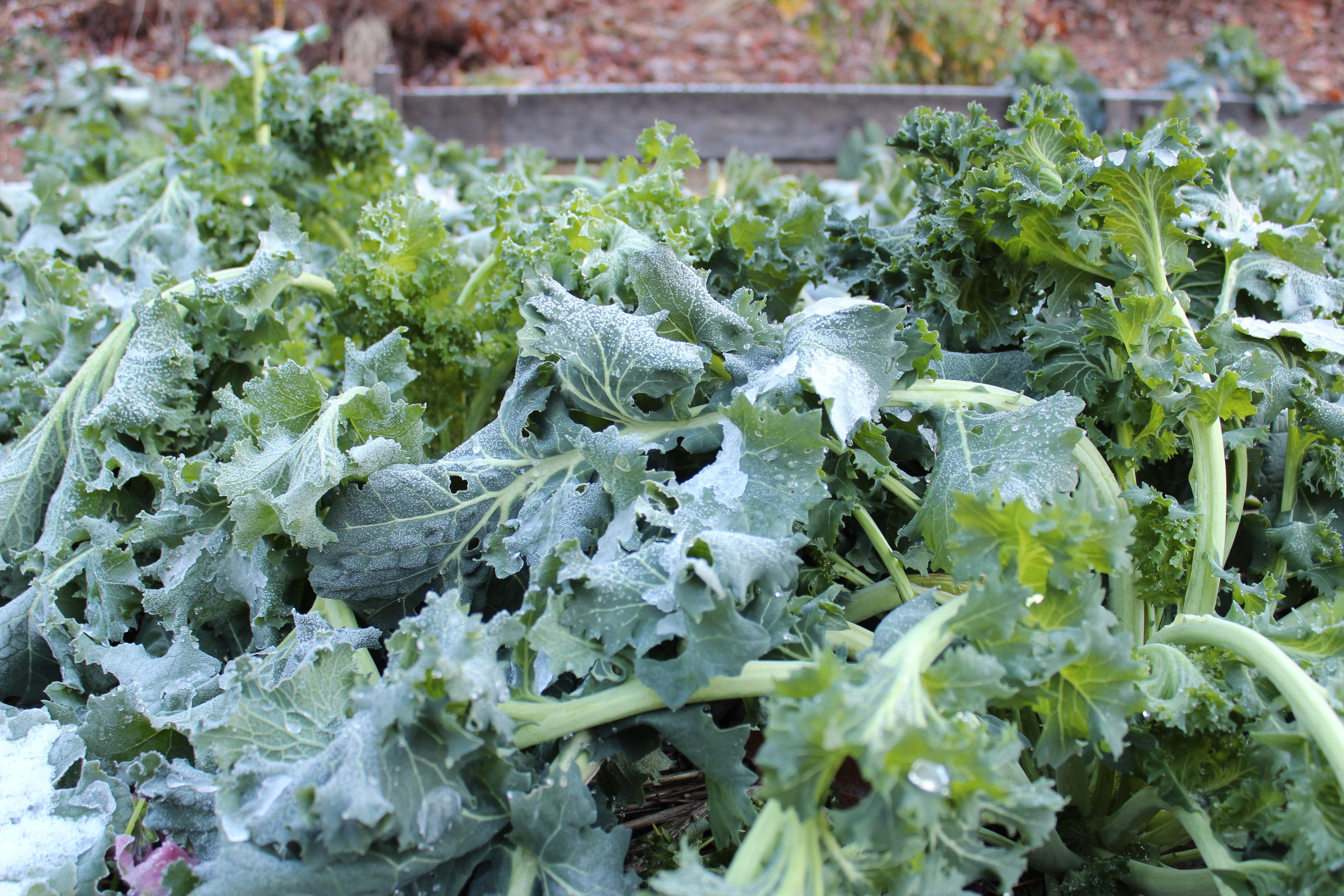Do you know your frost dates? These dates can sometimes be elusive to gardeners, and a little confusing, however, with a little patience and understanding you can sort out your frost dates and have success in your garden!
What are frost dates?
Frost dates are the days (on average) in every zone that that area experiences its last frost in the spring and its first frost in the fall. Between these dates are the days where the temperature does not dip below 32 degrees F. In many places this means summer and temperatures stay high above that 32 degree threshold. Learning how to grow in your growing zone is an essential part of understanding frost dates.
These times that don’t experience frost are great days for growing our frost-sensitive, warm season crops. Before and after these days are the best times to grow our frost-hardy, cool season crops. Think of these days as gates that open and close, ushering you into the next part of the season.
Below 32 degrees F, there are thresholds including light frosts, moderate frosts, and hard frosts. Between 32 and 29 degrees, it’s considered a light frost. Most tender plants will be killed back, however many cool weather and frost tolerant plants can easily handle this type of freeze and their flavor will even get sweeter.
Between 28 and 25 degrees F, the freeze is widely destructive to most plants. There may still be bits and pieces to harvest but this is when you’ll truly find out how well your season extension methods are holding up.
A hard freeze is considered to be 24 degrees F and colder. This causes heavy damage to most garden plants.

What is your frost date?
So, we bet you’re wondering about your own frost dates! This handy tool can help you find your frost dates based on your location. However, there are certainly a few things to keep in mind.
Here in Asheville, NC, the last frost is, on average, April 13th and our first frost is, on average, October 26th. These dates are estimates. Around here it is pretty much universally accepted that if you plant out your tender summer crops before Mother’s Day (the first weekend of May), there will be a late frost that kills them back. This of course is not reflected in the April 13th frost date, but it is something that experienced gardeners know and understand. Typically in the spring, folks should wait about two weeks after their average frost date to plant out those tender summer crops - or risk losing the seedlings you worked so hard to grow.
In the fall, the frost date is average too. It’s not always quite as predictable as the spring frost - there isn’t a reliable two week rule. However, as the shorter days start creeping in, it’s a good idea to keep an eye on the weather forecast, and just ensure that you’ve harvested everything you need to harvest before that frost comes rolling through.
Frost dates have no end of nuance. Especially in mountainous regions, even depending on your garden's location, it can be the deciding factor of when your frost date actually occurs. Cold air is heavier than warm air and tends to settle in valleys. These are referred to as frost pockets. Gardens in lower elevations in mountainous areas can experience frost sooner than gardens higher up. Over time, you will learn how your garden responds to weather. But your areas’ frost dates are good guidelines to get you started.

Gardening Tips: How do you prepare for the last frost?
Many folks look forward with glee to the last frost! However, it can mean the end of your crispy crunchy spring crops. Here are a few ways to prepare:
- As the weather warms up, be sure to water your spring crops in the morning! This will help to prevent sun-stress.
- Harvest as much as you can from your cool-weather spring crops.
- Don’t get excited and plant out your tender summer crops before you’re sure you’re in the safe zone.
- Try intercropping! Plant cover crops or fast-growing, tall summer crops next to your cool season crops to try to offer some shade as the weather warms up.
- As your spring crops begin to bolt, this is when you know their stress is telling them to produce seed. Leave them in the ground to harvest the seed or compost them! As they start to bolt their flavor may become bitter.
Gardening Tips: How do you prepare for the first frost?
The first frost can be a sad time to many gardeners, but it doesn’t have to be! We look at the first frost as an opportunity. Here’s how you can be prepared:
- Be sure to keep an eye on the weather and harvest any tender vegetables including the last of your tomatoes, peppers, squash, beans, and corn.
- Prepare your frost cloth and cold frames for tender salad greens. Lettuce is cold tolerant but frost sensitive and will last longer if protected.
- Keep your fall crops well-watered. Water holds heat and will help insulate the root structure of your crops, preventing cold injury.
- Apply mulch to perennials to hold moisture and heat throughout the winter.
- Ahead of time, plan your season extension techniques ahead of time so you’re ready to extend your harvests into the winter.

Cool Weather Crops
Even as the frost sets in (or before it ends), there are plenty of crops you can grow throughout the fall or even into the winter! In fact, some vegetables actually get tastier after a frost! Frosty weather helps the starches in the roots of these crops turn to sugar so they taste sweeter.
Arugula
Arugula is a delicious green that makes great bitter-greens salads and adds a fresh crunch to pizzas as well. It’s extremely cold hardy and is easy to grow in cooler weather. This crispy, peppery green makes for a great addition to any winter garden!
Beets
Beets are a delicious cold tolerant root crop that also offers edible greens. In fact, they’re related to swiss chard! The sweet roots can be harvested all winter long and add fresh nutrients (and a delicious sweet flavor) to all of your winter dishes.
Broccoli
Broccoli can take patience and know-how to grow but it’s certainly worth the effort. It’s in the same plant family alongside cabbage and kale, however, you’re waiting to harvest the florets rather than the leaves.
Brussels Sprouts
Brussels sprouts from the garden aren’t your mother’s boiled sprouts! These stalks produce many small florets that are then harvested as the sprouts you eat. They’re delicious, despite their less than stellar reputation. This long season crop can be grown in spring or fall and can be easily overwintered for an early spring harvest.
Cabbage
Who doesn’t love a green that is also a storage crop? This cool weather vegetable is dynamic in the garden and the kitchen. Highly nutritious, cabbage can withstand cold temperatures, making it a great choice for winter nutrients and storage.

Carrots
Grow a delicious root crop (in a variety of colors), and impress your neighbors with carrots! This is a great spring and fall crop that can also be overwintered for a continuous harvest throughout the cold season. Most varieties will want loose, well-draining soil but if you’re stuck with clay soils like we are here in Asheville, there are short stumpy varieties for you as well.
Cauliflower
Cauliflower is another brassica in which you’re waiting on the florets rather than the greens, similar to broccoli. The main difference being is that cauliflower is typically blanched by its own leaves, which keeps the color that gorgeous white!
Collards
Collards are close cousins with cabbage and kale but can have more heat tolerance than other brassicas. This trait might contribute to the fact that they are a beloved traditional Southern crop. They get sweeter when touched by frost as well and can be cooked like any beloved garden green!
Kale
What garden is complete without kale? Whether you’re partial to curly kale, dwarf kale, or dino kale, there’s a variety that is meant to grow in your garden (and get cooked in your kitchen). It’s one of the most abundant and easy-to-grow brassicas out there and also gets even sweeter and more delicious as the temperatures cool down!
Leeks
We love leeks for their frost tolerance, flexibility in recipes, and deliciously mild onion flavor. They can be harvested at any stage and overwintered easily for harvest all winter and spring. They’re a long season crop - between 120 and 150 days - but low effort enough that this shouldn't dissuade you from growing them!

Lettuce
Who doesn’t love fresh salad greens? They certainly beat what you can buy bagged in the store. Lettuce is some of the easiest plants to grow - whether you’re partial to a buttercrunch head variety or a cut and come again mix. Lettuce is cold tolerant but tends to be frost sensitive and will benefit from some frost cloth or a cold frame for a longer harvest.
Peas
Peas are an excellent beginner-friendly crop. This legume is super easy to grow and also offers a high reward - delicious snap, snow, or shelling peas! It is cold tolerant but tends to be frost sensitive and will benefit from some row cover to protect their tender leaves and flowers from frost.
Radish
Not only easy to grow, but super fast too. Most radishes are typically ready to harvest within a month or two of planting! So delicious, crunchy with a spicy kick, we love growing radishes in the fall and winter.
Spinach
Another speedy one for the books! Spinach is fast and nutrient packed and extremely cold tolerant and frost hardy. It can be harvested at any size and thrown into just about any dish. We love growing spinach in the fall and winter because it seems to last and produce for so long! Whereas, in the spring, the heat can make it bolt quickly.
Swiss Chard
Related to beets, swiss chard is the leafy green dominant cousin! The thick, succulent leaves are great raw or cooked (we especially love to throw them into stews) and add a pop of color to the winter menu.

Frost Date FAQ
What are frost dates?
Frost dates are the dates in each growing zone that the first and last frosts of the season fall on average. The phrase on average is essential as frosts can come earlier or later than these dates. It’s important to keep an eye on the weather and temperatures as these dates come about.
Why are frost dates important?
Frost dates help ensure that we are planting the right things at the right time. Frost sensitive plants cannot be planted before the last frost date as a frost could come and kill them back. Heat sensitive plants should be planted and harvested well before the last frost date to ensure that they can mature without bolting in the heat and ruining your crop.
How can I find out my frost dates?
Frost dates are easy to find out with this handy tool or by learning about your growing zone.
When is it safe to plant after the last frost?
It is generally agreed that two weeks after your last frost date is when it’s most definitely safe to plant out frost tender crops in most growing zones.
Frost dates are essential to understand for any gardener. While a little confusing at first, they will quickly become a regular part of your gardening routine and plan. Ready to get planting? Check out our wide variety of heirloom and organic seeds for any growing zone (just make sure you plant them before or after the right frost date).


|
Article Written by: Hannah Gibbons |
|
About the Author: Hannah Gibbons, an employee at Sow True Seed since 2020, has nearly a decade of experience in the agricultural industry. Their passion for environmental education and regenerative agriculture has been the cornerstone of their work, aimed at making gardening accessible to all. |


